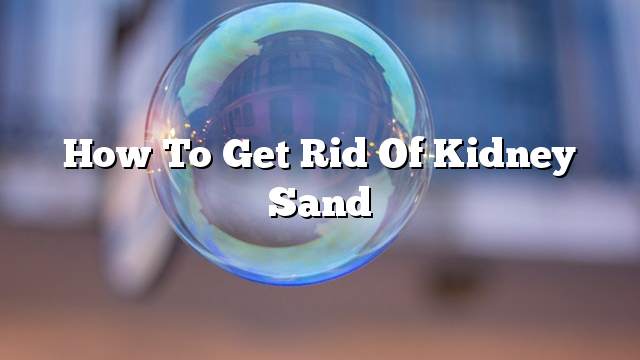Sand kidneys
Kidney sand, or so-called kidney stones, is one of the most common diseases of the urinary system. It is a solid mineral deposition formed in the urinary system as a result of the crystallization of some salts and minerals. In most cases, the size of the stones varies from patient to patient. Which may be larger than the size of a table tennis ball, and may be infected with kidney stones because of the presence of several factors helped to be, such as increased concentration of soluble substances in urine, or because of the lack of materials that prevent these deposits stick together, Composed of gravel, often The kidney stones do not cause permanent damage to the urinary system, but severe pain occurs to the patient, and when passing through the urinary tract.
Types of Kidney Sand
There are several types of sand kidneys, as the identification of the type of sand helps to know why they are made, and facilitates the process of treatment, and can be classified gravel, which consists in the college according to the composition to several types, including:
- Calcium Stones: It is one of the most common types of gravel, usually in the form of calcium oxalate or calcium phosphate; oxalate is more abundant in urine as a result of patients’ consumption of large amounts of oxalate-rich foods such as spinach, hazelnuts, chocolate and soy milk.
- Uric Acid Stones: It is usually formed in patients who do not drink enough water and rely on large amounts of protein in their diet.
- Cystine Stones: These stones are usually formed by a genetic defect that causes the kidney to release a large amount of amino acid Cystine.
- Struvite Stone: These stones are actually produced due to urinary tract infections, characterized by rapid formation and size.
Symptoms of renal sand
Symptoms may vary depending on the position of the patient in terms of location and size of the stones, if the stones are small size, they may go on their own without pain, while symptoms begin to appear when the stones are large, as they prevent the flow of urine, which may cause severe pain, and in these The patient may feel the following:
- Pain can be described as sudden and sharp waves on one side of the back or abdomen, may go down the thighs, and the pain becomes more severe over time, and usually start pain in the late hours of the night, or early in the morning, In these times. Pain from kidney stones may also change, in terms of pain severity and location, due to the transfer of gravel to another site in the urinary system.
- Change urine color to pink or brown.
- Increase the number of urination times and in few quantities.
- The feeling of nausea, vomiting, or fever and chills indicates the presence of inflammation.
Cases that require a doctor visit
Consult your doctor if there are any symptoms mentioned previously, which confirm the presence of gravel. If the patient has severe pain accompanied by nausea, vomiting and fever, or began to appear in the urine with difficulty in urination then consult your doctor immediately.
Get rid of kidney sand
Depending on the size, the smaller the size of the gravel, the better the kidney stones are. In these ways:
- Drinking a large amount of water: Drinking about six to eight glasses of water a day helps urinate, and thus facilitates the extraction of gravel, but for patients who can not drink water because of nausea and vomiting can be given fluids intravenously.
- Some medications:
- Antihistamines: In case of bacterial infection.
- Drugs that work on urination.
- Sodium bicarbonate salt.
- Phosphorus solution.
- Allopurinol (Allopurinol): To treat uric acid stones.
- The gravel is so large that it can not pass through the urinary tract.
- The pain is so severe that it can not be controlled.
- Obstruction or inflammation of the urinary tract due to gravel.
Prevention of renal sand
These health changes help prevent and prevent kidney stones.
- Drinking plenty of water: Drinking plenty of water helps reduce the concentration of dissolved solids in the urine, thus preventing the formation of gravel.
- Avoid eating foods rich in oxalate (eg spinach, hazelnuts, chocolates, soy milk) and reduce the intake of foods containing many salts (eg, fish, red meat, eggs and cheeses). .
Factors that increase the chances of kidney stones
In fact, all the people in general are vulnerable to kidney stones, but there are factors that increase the chance of the formation of gravel, such as drinking low and insufficient amounts of water, which is one of the most common causes of gravel, and also overweight, and eating foods rich in salts and proteins, Men are more likely to have kidney stones than women, and those who have had kidney stones are more likely than others to become infected again.
